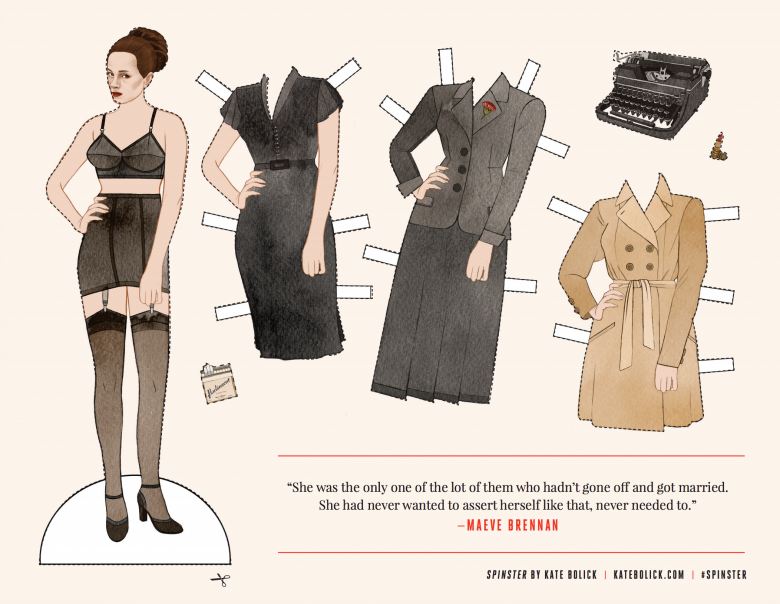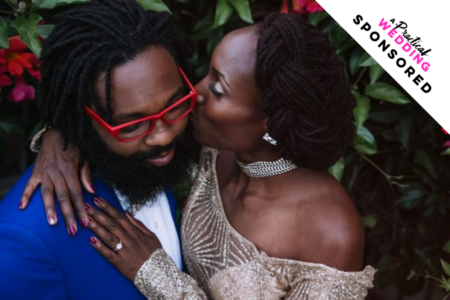
Not long into elementary school, we realized a man never changed. He was permanently and always a mister. But as Miss Priest went away in the summer and returned Mrs. Benson in the fall, we learned quickly that a woman was a creature unfixed, defined by different terms. Her wedding day was a pivot upon which she turned into someone else, new not only in name but also in the way she was to be addressed. This transformation from Miss to Mrs., unwed to wed, remade her.
There was a third mode of address—the Ms.—the hybrid that always had me wrinkle my nose. Why would you ever be a Ms.? The title seemed to stink of desperation. It said, “Too old to be unmarried, but not married yet.” It said “spinster.” I realized just last week that I will now always be Ms. Tomscha, because I’m keeping my own last name, never ended up with a doctorate, and hell, I no longer think it’s anyone’s business if I’m married or not. The honorific isn’t a desperate one. Ms. is elusive, ambivalent, resistant.
This was why I was interested in Kate Bolick’s new book Spinster. I’d heard of Bolick before: she’s one of the only women to have made the cover of the Atlantic Monthly (her compatriots include Condi, Hillary, and Britney). She’s featured on the November 2011 issue, her arms crossed defiantly, a dark sweep of bang threatening her left eye. Below her, the headline: “What, Me Marry?” While The Atlantic‘s taken to publishing a number of intentionally controversial gender pieces, Bolick’s article “All the Single Ladies” (tagged under “Health”) was more than click bait. It was good journalism. In the piece, Bolick considers the state of marriage—or rather, the state of its decline—across a spectrum of races and classes. Her writing manages that delicious blend of the researched and the personal. Although in 2011 I knew I would choose marriage (Dan had begun hanging around), I admired Bolick’s willingness to explore her own resistance so publicly.
In Spinster, Bolick also sets out to challenge how our maritial status defines us. “Whom to marry, and when it will happen–these two questions define every woman’s existence,” Bolick begins. Could we imagine a world in which marriage wasn’t a crucial part of a woman’s identity? “What if a girl grew up like a boy,” she asks. What if marriage was “a thing she could do, or not do, depending. What would that look and feel like?” Of course, Bolick doesn’t mean that we are obligated to get married—we aren’t—but she does argue (and rightfully so) that women are often raised to see marriage as the center of our life narratives. And even if we don’t or don’t want to, the question of marriage keeps popping up, like an obnoxious photobomber.
Spinster isn’t a book surveying the modern state of marriage. Bolick doesn’t take the same approach here that she had in her 2011 article. Instead, to help her in thinking about these issues, Bolick looks for historical models, women who’ve inspired her. She chooses five women, most of whom lived and wrote over a century ago: Neith Boyce, Edna St. Vincent Millay, Charlotte Perkins Gilman, Edith Warton, and Maeve Brennan. She calls these five women her “awakeners,” and she alternates descriptions of their lives with stories from her own. This structure splits Spinster into two distinct threads. Sometimes the book reads like a well-researched biography of five different early twentieth century women. At other times, in writing about her own experiences, Bolick gives us the classic, moving-to-the-City, young-woman-in-publishing narrative à la Carrie Bradshaw. She writes vividly about her relationships with a series of men denoted only by capital letters (the college lover is “W,” a latter charming coworker-turned-partner “R”,” her current boyfriend “S”), all of whom seem pleasant enough. Why can’t she pick one, Bolick wonders. But the question is why won’t she?
We’re never quite sure what it is exactly that Bolick finds so off-putting about marriage. She does worry that couples become an echo chamber, “with each party exaggerating or repressing certain qualities in relation to the other’s” (see: my biggest fear). She returns to what she calls a “spinster wish,” a deeply-rooted desire for aloneness. In the end, Bolick thinks we should stop distinguishing between the singles and the smug marrieds. “Whether to be married or to be single… is a false binary,” she writes in her closing chapter. We should reclaim the word “spinster,” to be used as a “shorthand for holding on to that in you which is independent and self-sufficient, whether you are single or couple.” The book ends with a call—not toward rallying in the streets, but to a clear-hearted acknowledgment that we can be self-fulfilled, alone or coupled. I suspect Bolick would be a fan of Meg’s “Self-full Wife.”
A PROBLEM WITH THE PROJECT
In my writing workshops, I’m careful to remind students that we must take one another’s stories and essays on their own terms. What is the writer’s project? we ask. If the writer doesn’t want to write a Christian pioneer novel, I can’t ask her for covered wagons. Only when we come to understand what the author envisions for the story can we begin to think about how the story might be improved. “You should have done this [completely opposite thing]” is an easy critique to make. And often an unhelpful one. This critique relies on a consumer impulse, as though the story were a product that can be returned.
Bolick sets out her project in very clear terms, but underlying this smart and much-needed project are a couple of troubling assumptions. In her first chapter, Bolick claims to have “happened upon [her] five awakeners with a similar hopscotch of happenstance and instinct.” This is how many of us choose our role models. We can only draw inspiration from those we encounter in the first place, those whose words ring inside of us like a clear bell. Fair enough. Bolick recognizes from the beginning that this hodgepodge (grouped together for a book proposal, let’s be honest) means that she couldn’t chose every inspiring turn-of-the-century woman; she had “discounted scores of perfectly acceptable candidates.” One example she gives is the writer and critic Mary McCarthy, whom Bolick calls “many a bookish girl’s imaginary avatar.” Why doesn’t McCarthy make the cut? In additional to being too emotionally distant, McCarthy “grew up in Seattle and Minneapolis, two cities,” Bolick writes, “I know nothing about.” But is Minneapolis really that mysterious? Evidently, Bolick’s world is limited to the northern half of the I-95 corridor.
But even the true diversity of this corridor isn’t represented in this book. At all. In her opening chapter, Bolick announces, “Four of my five awakeners were redheads.” Although I believe Bolick that this is a true coincidence, I wondered why she thought this fact worthy of its own paragraph. I suspect I know the answer from my study of fiction. Open two novels, and you’ll find at least one with a red-headed heroine. Red hair is a way of making a character “other” without making her Other. Red hair is spunky, independent, unique, and oh so white.
All of Bolick’s five awakeners were also white women. She addresses this choice immediately. “Not until I was driving through my blindingly white hometown [of Newburyport, New Hampshire]… did I realize that the only characteristics all five women had in common were a highly ambivalent relationship to the institution of marriage, the opportunity to articulate this ambivalence, and whiteness—each of which, arguably, was inextricable from the rest.” So Bolick is aware of the book’s racial homogeneity. But then she continues: “During the period I was drawn to—primarily, the turn of the century—vanishingly few women of color were given the privilege to write and publish and, therefore, to speak across the decades. And then the thinking ceased and muscle memory took over and I turned left onto our street, pulled into the driveway, and parked the car.”
Bolick argues here that non-white women couldn’t “speak across the decades,” burt a quick Google search proves that these women were writing and we have access to this writing. With this turn into her driveway, Bolick’s consideration of race as an aspect of women’s identity is done. She cannot imagine herself being guided by a woman from Seattle, never mind a black writer who didn’t have access to mainstream publishers. She announces her white privilege and then “the thinking ceased.” Note the passive construction of this phrase. She doesn’t stop thinking: the thinking just… ends. Bolick goes on autopilot—and autopilot for her and for other Americans of privilege is when the very fact of that privilege recedes. White America is America, right?
Although Bolick herself cannot be bothered even to see beyond I-95, we readers—regardless of our own geographies, races, cultures, or classes—are invited to try to see beyond our own particularity into hers. If we buy this book, if we give the author our time, this is exactly what we must do. This is the problem with the book’s project, expressed so wholly and ignorantly in a single paragraph. Frankly, I’m shocked that this paragraph was approved by her editor at Crown, but perhaps it shouldn’t have been.
It’s 2015, and in publishing, whiteness is still rendered as the universal experience, that from which all people can draw inspiration. The white, heterosexual woman reigns as the Everywoman.
In her New York Times review of the book, Heather Havrileskey writes that Spinster “sets forth a clear vision, not just for single women, but for all women: to disregard the reigning views of how women should live and to carve out a little space for their dreams, preferably with eleven-foot ceilings.” But although it means to be, Spinster is not a book for all women. Not because of the eleven-foot ceilings, but because of the scope of the project.
Why does it matter whose histories Bolick represents? It’s her book, after all. Her choice, her own feelings of inspiration. We can’t expect to see our own lives mirrored in everything we read. Still, it’s troubling to me that Bolick didn’t feel obligated to consider the implications of her “ad-hoc approach.” These five historical women are resurrected through Bolick’s research and careful prose, and these resurrections have consequences. I know Edna St. Vincent Millay better now than I did before I began Spinster. I gave Millay’s life and her poetry my time; Bolick brought her into my mind. We resurrect those to whom we have access, and we have access to those women others have already resurrected.
Bolick’s right that we need to redefine the relationship between women and marriage. Maybe one day, marriage will be as peripheral or as central to a woman’s self-narrative as she chooses to make it. But as important as this issue is, Spinster unintentionally reminded me that for many women, this fight is not the only one.






